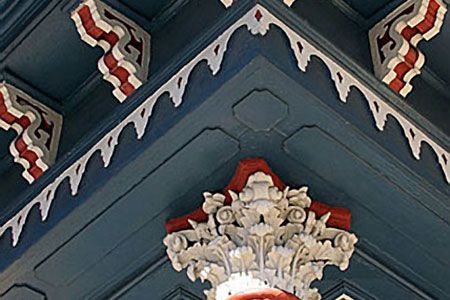The color you choose for your home can dramatically change its look and curb appeal. It can reflect your personality, complement your home’s unique architecture, or blend in with the natural surroundings. This guide will help you decide what direction to go when you choose an exterior color for your home. We’ll walk you through different approaches to provide inspiration and practical tips.
Stone Grays for a Classic Exterior

When choosing exterior colors, it’s easy to start with elements that are already established, such as stone or brick. These materials often have a range of hues that can serve as a foundation for your color scheme. For instance, in the case of a Gothic-style entry, the grays of the stone and roof provide an excellent starting point. However, using too much gray can create a somber atmosphere. To counterbalance this, consider incorporating a warm, rich color like burgundy red as an accent for doors and windows.
To create a balanced color scheme, paint other surfaces in complementary shades. For example, use an off-white or a lighter shade of gray for larger areas to brighten the overall appearance. This technique highlights architectural details while blending in nicely with the existing stone elements. Adding a touch of verdant greenery through landscaping can also soften the gray tones and help create a welcoming exterior.
Soft Neutral Colors for a Welcoming Home
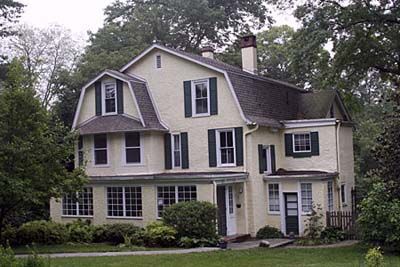
If you’re looking for a foolproof approach to exterior colors, opting for a light, neutral color is always a classic choice. This helps your house appear welcoming and cheerful rather than dark and imposing. Light neutral tones, such as soft beige, pale gray, or warm taupe, complement various architectural styles and landscaping elements.
To add more emphasis to the overall look, use white for window trim and other structural details like bargeboards on the roof edge. White looks clean and fresh and helps reflect more light indoors to brighten your interior spaces.
Consider using a darker color as an accent for add-on features such as shutters. This three-color approach—light neutral for walls, white for trim, and a dark accent color—creates a classic, timeless look that appeals to a wide range of tastes. Plus, neutral tones tend to wear gracefully over time.
Bright Contrast to Make Your Home’s Exterior Pop
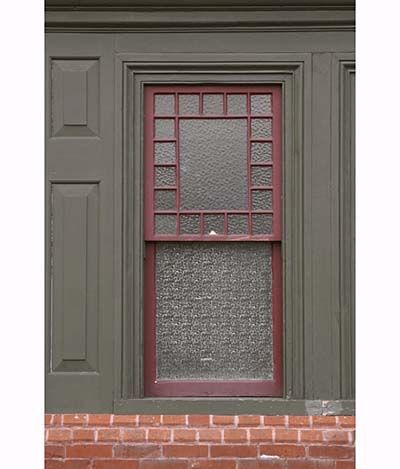
If you want to give your home a bright, lively appearance, you can choose colors that are opposite each other on the color wheel. This creates a dynamic visual contrast that helps your home stand out. This look is a good choice for vintage houses that have more detailed architectural features to use for contrast.
While green and red are opposite on the color wheel, using pure versions of these colors could result in a Christmas-like appearance that may not be a good choice year-round. The key lies in toning down both colors by adding similar amounts of gray. This process, known as muting, creates more subdued versions of the original hues that still complement each other beautifully. The result is a sophisticated color scheme that adds character to your home while still maintaining a timeless appeal. Incorporating natural wood elements and neutral fabrics in your outdoor furniture can also help soften the overall look.
Cool Blue Paint For an Elegant Home
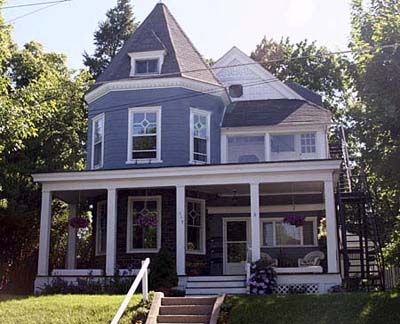
Blue is a bold choice for exterior paint, as it’s not typically associated with the earth tones commonly used in home exteriors. However, when chosen well, blue can create a striking and elegant appearance. Grayish shades of blue resemble the natural color of slate, helping the hue feel more grounded in nature.
While blue is known for creating a cool atmosphere indoors, its effect on exteriors is less pronounced. When combined with white trim and surrounded by green landscaping, a blue exterior appears crisp, calm, and inviting. This color choice can work well for coastal homes or those in cooler climates, as it complements the sky and other natural surroundings. Consider the style of your home and the colors of neighboring houses when selecting the perfect shade of blue. You can also lean into the blue palette by adding bluish-gray stones or paths in your garden area.
Bold Black Accents for a Sophisticated Exterior
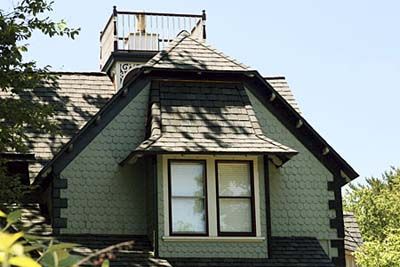
While an all-black house might be too bold, using black as an accent color can be sophisticated and elegant. The sharp contrast can serve as the perfect finishing touch to add pop to the overall look. Black accents can be particularly striking on window frames, doors, or other architectural details, creating a contrast against lighter colors.
For a softer approach, consider using very dark shades of other colors that read as black from a distance. For example, an extremely dark green can provide the same dramatic effect as black without being quite as sharp of a contrast. For balance, pair these dark accents with a light neutral wall color and creamy white trim. This combination creates a timeless, elegant exterior that will turn heads. Introducing elements like black planters or wrought-iron railings can also complement this sophisticated look.
Emphasis on Exterior Architecture
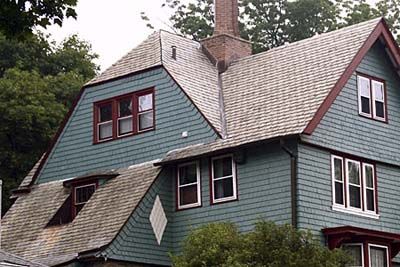
Your home’s outdoor paint should highlight its best architectural features, much like a well-chosen outfit highlights a person’s best attributes. The best way to achieve this is to establish a clear hierarchy of colors and their placement. Each hue should serve a purpose in showcasing your home’s character.
In the example provided, green is used on all non-stone walls, including the half-wall around the second-floor porch and the base of the bay window. This creates a cohesive backdrop that allows other elements to stand out. The innermost trim pieces are painted white for a crisp contrast, while the remaining trim is painted red, adding a bold accent that draws the eye to key architectural features.
By thoughtfully using colors, you can create a visually striking exterior that celebrates your home’s design. In addition to paint, decorative elements such as colored flower pots and unique mailbox designs can further highlight your home’s best features.
Victorian Beauty for a Home’s Exterior
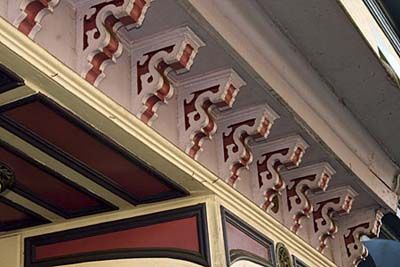
Victorian-era architecture is known for its ornate details and embellishments. The philosophy of the time was that if one detail was good, two were better, resulting in homes adorned with intricate woodwork, decorative trim, and elaborate architectural elements. When choosing a color scheme for a Victorian home, you want to highlight these design features.
Paint schemes featuring several colors with sharp contrasts are a great way to highlight the architectural intricacies of Victorian homes. The more detailed the home, the bolder you can be with your color choices. For example, highly ornate elements like corbels can showcase a dramatic contrast between light and dark colors, while less detailed areas, such as panels underneath, can be painted in two complementary dark colors. This approach respects the home’s historical character and celebrates the era’s craftsmanship. Introducing gold or brass accents on railings and light fixtures can add an extra touch of Victorian sophistication.
Painting Your Exterior With Several Colors
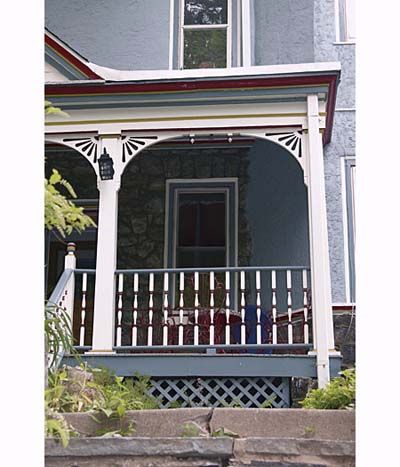
The Queen Anne architectural style flourished in the 1880s and 1890s, coinciding with a period when builders gained access to a wide array of factory-made house parts. This newfound availability of ornate elements led to designs featuring elaborate fretwork, turned balusters, and other decorative details.
When choosing colors for a Queen Anne-style home, embrace a similarly exuberant approach. Bold, contrasting colors can highlight the various architectural elements, creating a lively and eye-catching exterior. Consider using a combination of three or more colors to accentuate different features, such as gables, trim, and decorative shingles.
While this style allows for creative expression, maintain a cohesive overall look by choosing colors that complement each other. Adding complementary garden decor and stained glass on accent windows can help highlight the home’s historical elements even more.
Highlight Lines to Detail a Home
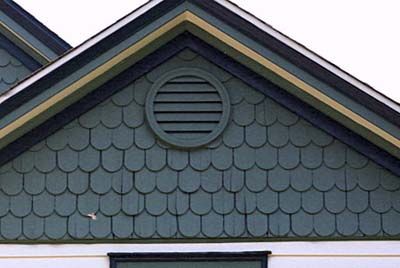
While highlighting every architectural detail with different colors can create a stunning effect, it can also be expensive and time-consuming. Detailed painting requires careful brushwork, which is more difficult and expensive than spray painting larger areas. Strike a balance between visual impact and practicality with a compromise.
One effective approach is to use a single color for walls and any elements embedded in them, such as vents. This creates a uniform backdrop that can be easily spray-painted. Then, use detailed color work only on specific areas, such as the ends of the eaves. That way, you can showcase a few architectural features while still keeping the painting process manageable and cost-effective.
Natural Wood to Frame a Home
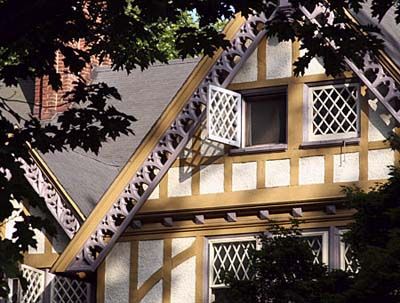
Half-timbered construction uses exposed wooden framing with infill between the timbers. This distinctive architectural style continues to be popular in revival architecture. Respect the historical roots of this construction method when choosing colors to paint your home.
Painting the exposed timbers in shades of brown, ranging from rich mahogany to lighter tan hues, is an excellent way to honor the traditional appearance of half-timbered homes. These earth tones look authentic and create a warm, inviting exterior. For the infill areas between the timbers, use a light neutral color such as cream or off-white for contrast. This color combination highlights the unique structural elements of the home while maintaining a timeless appeal. Adding plants with deep green foliage can enhance the natural feel of this architectural style.
Monochromatic Color Schemes for Your Exterior
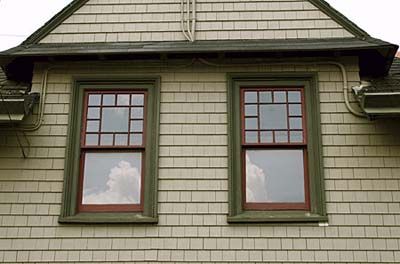
Monochromatic color schemes, based on variations of a single color, create a sophisticated and cohesive look. You can still add contrast by adding various amounts of black or white to the base color to create different shades and tints. While this approach can produce a calm and elegant appearance, some homeowners may find it too understated.
To add visual interest to a monochromatic scheme without compromising its overall harmony, you can add small amounts of a complementary color. Complementary colors are found opposite each other on the color wheel. For example, if your main color is green, red would be its complement. Using red as an accent color in small doses, such as on the front door or shutters, can add a pop of contrast that brightens the entire exterior without overwhelming the primary color scheme. Adding thoughtful landscaping with flowers or plants in complementary hues can add more punch to the look.
Seasonal Decor for Your Exterior
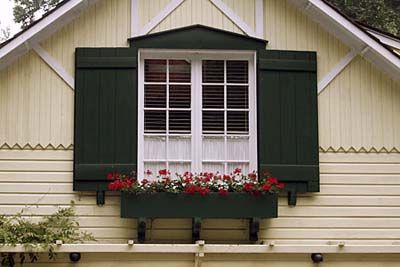
Choosing exterior colors for your home can feel like a huge decision since you’ll be living with the results for years. However, you can still introduce variety and seasonal charm without repainting the entire exterior. Temporary decorations and plantings can make a big impact on your home’s curb appeal and give you a way to refresh its style throughout the year.
For example, bright red geraniums can add a vibrant note to a gable end during the spring and summer months. When these flowers fade, you can replace them with seasonal decorations such as autumn wreaths or winter garlands. You can also use banners, window boxes with changing floral displays, or even temporary lighting to alter your home’s appearance and keep it looking fresh and inviting year-round. This approach allows you to maintain a timeless base color scheme while still enjoying seasonal changes. Seasonal outdoor furniture cushions and hanging decorations can also be good ways to punch up your home’s outdoor style.
